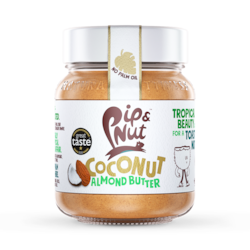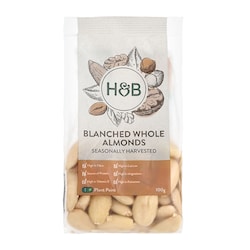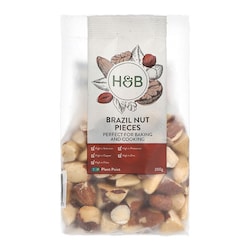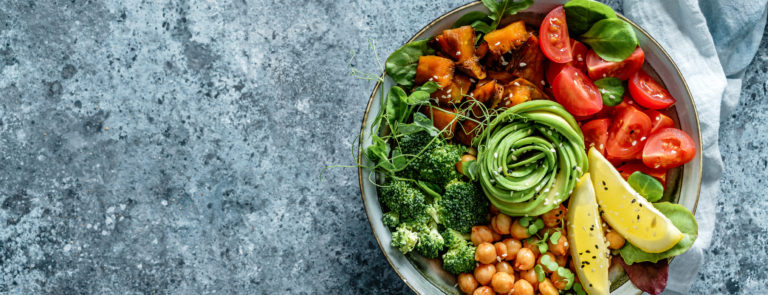20% off £30
A - Z list of different types of nuts - 25 kinds
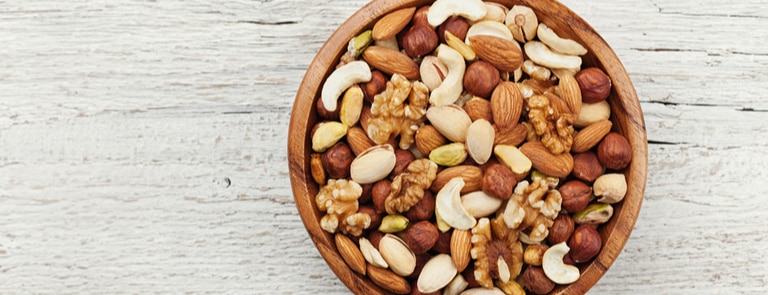
There are lots of different types of nuts, some very popular like almonds and cashews, and some not-so like gingko nuts and paradise nuts.
In fact, there are a lot of foods with ‘nut’ in their name, like coconut and tiger nuts, that are technically not a nut at all.
Here’s a 25-part list of types of nuts, what they’re good for and how you can use them.
-
Acorns
When you think of acorns, it’s hard not to imagine them in the clutches of squirrels and other woodland critters. But did you know humans can enjoy acorns too?
Acorn benefits
- They’re full of natural protein and healthy fats
Best for:
- Roasting and adding to winter stews
- Slow-roasting and grinding to make acorn coffee
- Roasting and stirring into melted sugar / honey / syrup to make acorn brittle
Acorn nutritional info
The below table shows a breakdown of the nutritional info for 28g of dried acorns:1
| Nutrient | Value | % of RDA* |
|---|---|---|
| Calories | 142kcal | 7% |
| Carbohydrates | 15g | 5% |
| Protein | 2.3g | 5% |
| Fat | 8.8g | 14% |
| Manganese | 0.4mg | 19% |
| Vitamin B6 | 0.2mg | 10% |
Where to find them
You can buy processed acorns online and in some health shops, or you can forage for them in woodland areas.
However, you must make sure to wait until acorns are ripe and have turned brown, making sure to forage sustainably so enough acorns are left for the local wildlife.2
Raw acorns contain tannins that can be toxic to humans, horses, cattle and dogs – and they make them taste pretty bad too!
However, you can ‘leach’ acorns to make them safe for humans to eat.
How to 'leach' acorns
- Shell the acorns.
- Soak them in hot or cold water.
- When the water turns brown, drain the acorns and repeat the soaking process.
- Repeat the process until water is clear.
-
Almonds
Slithers of natural, nutty sweetness, almonds are definitely one of the most popular (and delicious!) nuts around.
If we’re being entirely factual here, though, almonds aren’t technically nuts. They have a fleshy outer layer that is removed in processing, making them seeds.
Almond benefits
- One of the most protein-packed nuts around
- A good source of magnesium, which is good for cell health and lots of bodily processes
Best for
- Making cherry Bakewells / Bakewell tarts
- Adding into trail mixes
- Almond flour for a gluten-free flour alternative
- Making Romesco sauce
- Enhancing fruit crumbles
- Making your own almond milk
Almond nutritional info
The below table shows a breakdown of the nutritional info for 28g of blanched almonds:3
| Nutrient | Value | % of RDA* |
|---|---|---|
| Calories | 163kcal | 8% |
| Carbohydrates | 5.6g | 2% |
| Protein | 6.1g | 12% |
| Fat | 14.2g | 22% |
| Fibre | 2.9g | 12% |
| Vitamin E | 6.9mg | 35% |
| Manganese | 0.6mg | 31% |
| Magnesium | 77mg | 19% |
Where to find them
Almonds are pretty commonplace, so you’ll probably find them in your local supermarket or health food shop.
You can get:
- Raw almonds (skin on)
- Blanched almonds (skin removed)
- Roasted almonds
- Almond butter
-
Brazil nuts
One of the grandest and tastiest nuts out there, Brazil nuts are buttery, smooth, and ready for you to love them!
Brazil nut benefits
- They’re one of the most concentrated dietary sources of selenium - a mineral that works like an antioxidant to protect our cells
- Selenium also supports our immune system
Best for
- Smothering with chocolate for snacks
- Crushing up and sprinkling on salads
- Making pesto
- Adding into bakes
- Mixing into trail mixes
Brazil nuts nutritional info
The below table shows a breakdown of the nutritional info for 28g of dried, unblanched brazil nuts:4
| Nutrient | Value | % of RDA* |
|---|---|---|
| Calories | 184kcal | 9% |
| Carbohydrates | 3.4g | 1% |
| Protein | 4g | 8% |
| Fat | 18.6g | 29% |
| Fibre | 2.1g | 8% |
| Selenium | 537mcg | 767% |
| Magnesium | 105mcg | 26% |
| Copper | 0.5mg | 24% |
Where to find them
Brazil nuts are pretty commonplace, so you’ll probably find them in your local supermarket or health food shop.
You can get:
- Whole brazil nuts
- Chocolate brazil nuts
-
Cashew nuts
Another nut that is technically not a nut, is the humble cashew! These kidney-shaped seeds come from the cashew tree native to Brazil.
Although they are commonly called a tree nut, they are actually seeds that have very similar nutrition to other nuts, like healthy fats, protein and minerals like copper.
Cashew nut benefits
- Supports healthy iron levels
- Full of magnesium and manganese, which help keep bones healthy5
- Low in sugar yet rich in fibre, protein and healthy fats
Best for
- Simply snacking
- Making vegan cheese or creamy sauces
- Adding to South East Asian dishes like curries or rice dishes
- Making pesto
Cashew nuts nutritional info
The below table shows a breakdown of the nutritional info for 28g of raw cashew nuts:6
| Nutrient | Value | % of RDA* |
|---|---|---|
| Calories | 155kcal | 8% |
| Carbohydrates | 9.2g | 3% |
| Protein | 5.1g | 10% |
| Fat | 12.3g | 19% |
| Fibre | 0.9g | 4% |
| Copper | 0.6mg | 31% |
| Manganese | 0.5mg | 23% |
| Magnesium | 81.8mg | 20% |
| Phosphorus | 166mg | 17% |
Where to find them
Cashew nuts are one of the nation’s favourite ‘nuts’ so you should be able to find them in your local supermarket or health shop.
You can get:
- Whole, natural cashew nuts
- Honey roasted cashews
- Roasted salted cashews
- Chocolate cashews
-
Chestnuts
Whether you roast them on an open fire (as the famous Christmas song suggests!) or you prefer them in a hearty stew or nut roast, chestnuts are delicious and full of goodness.
Chestnut benefits
- Rich in vitamin C, which is good for energy levels, immune system function, bone and cartilage maintenance
Best for
- Roasting
- Making stuffing
- Nut roasts
- Coating with chocolate
- Adding to bakes and tarts
Chestnuts nutritional info
The below table shows a breakdown of the nutritional info for 28g of raw, peeled chestnuts:7
| Nutrient | Value | % of RDA |
|---|---|---|
| Calories | 54.9kcal | 3% |
| Carbohydrates | 12.4g | 4% |
| Protein | 0.5g | 1% |
| Fat | 0,4g | 29% |
| Fibre | 2.1g | 1% |
| Vitamin C | 11.3mg | 19% |
Where to find them
You can usually find chestnuts pre-cooked in supermarkets/health food shops as they are much easier to cook with. That being said, you can find fresh ones if you look a little harder!
You can get:
- Fresh chestnuts
- Roasted chestnuts
-
Hazelnuts
Squirrel’s go mad for hazelnuts, so maybe you should do the same and get just as bright-eyed and bushy-tailed as those little critters!
They’ve been eaten by humans for over 9000 years, as the hazel tree is native to Britain, Europe and Western Turkey.8
Hazelnut benefits
- Supports heart health with healthy fats, vitamin E, copper and magnesium9
Best for
- Cheesecake bases
- Bakes, especially brownies!
- Making your own chocolate-hazelnut spread
- Hazelnut pesto
- Homemade granola
- Hazelnut and apricot stuffing
Hazelnuts nutritional info
The below table shows a breakdown of the nutritional info for 28g of raw hazelnuts:10
| Nutrient | Value | % of RDA* |
|---|---|---|
| Calories | 176kcal | 9% |
| Carbohydrates | 4.7g | 2% |
| Protein | 4.2g | 8% |
| Fat | 17g | 26% |
| Fibre | 2.7g | 11% |
| Manganese | 1.7mg | 86% |
| Copper | 0.5mg | 24% |
| Vitamin E | 4.2mg | 21% |
| Magnesium | 45.6mg | 11% |
Where to find them
You probably won’t have trouble getting your hands on some yummy hazelnuts, especially as some of them are grown right on our doorsteps!
Check your local supermarket or health food shop.
You can get:
- Raw hazelnuts
- Chocolate hazelnuts
- Hazelnut spread
-
Macadamia nuts
A VIP of the nut world, macadamia nuts are the most expensive nuts in the world! So, what’s so special about them?
Well first of all, like so many other popular ‘nuts’, macadamia nuts are actually seeds.
They are considered a ‘dessert nut’ vs a commodity crop, like peanuts.
It takes 7 years for a macadamia nut tree to produce any ‘nuts’. Lastly, they are very delicious!
Best for
- White chocolate and macadamia nut cookies
- Coconut and macadamia cookies
- Double chocolate and macadamia brownies
- Spiced macadamia nuts
Macadamia nuts nutritional info
The below table shows a breakdown of the nutritional info for 28g of raw macadamia nuts:11
| Nutrient | Value | % of RDA |
|---|---|---|
| Calories | 201kcal | 4% |
| Carbohydrates | 4g | 10% |
| Protein | 2.2g | 4% |
| Fat | 21.2g | 33% |
| Fibre | 2.4g | 10% |
| Manganese | 1.2mg | 58% |
| Thiamin | 0.3mg | 22% |
Where to find them
Macadamia nuts are quite elusive by nature, hence their steep price tag. Your best bet is to order online or check out your local health food shop/market.
You can get:
- Natural macadamia nuts
- Macadamia milk
- Chocolate macadamia nuts
-
Peanuts
Think of a nut. Was it a peanut?
From their status as the most common salty bar snack to the gorgeously addictive nut butter they transform into, there’s no denying that peanuts have infiltrated themselves into our lives pretty well!
This cheap and highly accessible nut is good for you and very easy to include in your diet.
Peanut benefits
- High in healthy fats and fibre
- Rich in protein and contains all 20 amino acids, with high levels of arginine in particular12
- A great source of manganese, which is vital for many processes in the body.
Best for
- Roasting with honey or chilli
- Making peanut brittle with melted sugar/syrup
- Scattering into stir frys
- Blending into peanut butter
- Tartes, cakes, cookies and other bakes
- Chocolate and peanut butter bites
- Vegan walnut, cashew & peanut roast
Peanuts nutritional info
The below table shows a breakdown of the nutritional info for 28g of raw peanuts:13
| Nutrient | Value | % of RDA* |
|---|---|---|
| Calories | 159kcal | 8% |
| Carbohydrates | 4.5g | 2% |
| Protein | 7.2g | 14% |
| Fat | 13.8g | 21% |
| Fibre | 2.4g | 10% |
| Manganese | 0.5mg | 27% |
| Niacin | 3.4mg | 17% |
| Folate | 67.2mcg | 17% |
Where to find them
Peanuts are absolutely everywhere! Have a look for them in your local supermarket or health food shop.
You can get:
- Raw peanuts
- Honey roasted peanuts
- Chilli-coated peanuts
- Chocolate-covered peanuts
- Peanut-based snack bars
- Smooth peanut butter
- Crunchy peanut butter
-
Pecans
From pecan pies to delicious pecan-studded granola, the humble pecan is a buttery nut with a variety of tasty uses.
Pecan benefits
- Good for your heart with their healthy fats
Best for
- Pecan cookies
- Pecan pie
- Candied pecans
- Pecan flapjacks
- Dark chocolate and pecan granola
Pecans nutritional info
The below table shows a breakdown of the nutritional info for 28g of raw pecans:14
| Nutrient | Value | % of RDA* |
|---|---|---|
| Calories | 193kcal | 10% |
| Carbohydrates | 3.9g | 1% |
| Protein | 2.6g | 5% |
| Fat | 20.2g | 31% |
| Fibre | 2.7g | 11% |
| Manganese | 1.3mg | 63% |
| Copper | 0.3mg | 17% |
Where to find them
Pecans are fairly common, so you should find them in bigger supermarkets and in health food shops.
You can get:
- Whole pecans
- Pecan halves
- Candied pecans
- Crushed pecans
-
Pine nuts
Another famous nut that’s a ‘secret seed’ is the pine nut. It is packed full of minerals, vitamins and healthy fats, with some protein and fibre thrown in.
Pine nut benefits
- Rich in copper which helps support the immune system
- Contains plenty of omega-3s, which are good for your heart
- A great source of vitamin K, which is critical for blood clotting and bone health
Best for
- Making traditional pesto
- Adding to spinach and garlic for a lovely side dish
- Adding to pasta dishes for an extra nutritious bite
- Hearty casseroles
Pine nuts nutritional info
The below table shows a breakdown of the nutritional info for 28g of dried pine nuts:15
| Nutrient | Value | % of RDA* |
|---|---|---|
| Calories | 188kcal | 9% |
| Carbohydrates | 3.7g | 1% |
| Protein | 3.8g | 8% |
| Fat | 19.1g | 29% |
| Fibre | 1g | 4% |
| Manganese | 2.5mg | 123% |
| Copper | 0.4mg | 19% |
| Vitamin K | 15.1mcg | 19% |
| Magnesium | 70.3mg | 18% |
Where to find them
Pine nuts are pretty commonplace, so you’ll probably find them in your local supermarket or health food shop.
You can get:
- Raw pine nuts
- Roasted pine nuts
-
Pistachios
Ahh pistachios, one of the most delicious nuts out there – even if they’re a bit of a pain to get in to!
You’ll find these ever-so-sweet nuts in everything from pasta and pesto to ice-creams and baklava.
Pistachio benefits
- Full of antioxidants that can help defend your body from oxidative stress16
- A great source of plant protein
- Rich in heart-healthy fats
Best for
- Pistachio cakes, cookies and tarts
- Deliciously sweet baklava
- Adding a crunch to rice pilaf
- Pistachio ice cream
- Sweet and spicy candied pistachios
Pistachio nuts nutritional info
The below table shows a breakdown of the nutritional info for 28g of raw pistachio nuts:17
| Nutrient | Value | % of RDA* |
|---|---|---|
| Calories | 156kcal | 8% |
| Carbohydrates | 7.8g | 3% |
| Protein | 5.8g | 12% |
| Fat | 12.4g | 19% |
| Fibre | 2.9g | 12% |
| Copper | 0.4mg | 18% |
| Manganese | 0.3mg | 17% |
Where to find them
Pistachios are quite popular, so you’ll probably find them in your local supermarket or health food shop.
You can get:
- Natural pistachios
- Shelled pistachios
- Roasted and salted pistachios
- Candied pistachios
- Chocolate-covered pistachios
-
Walnuts
Walnuts have been part of the human diet for centuries – for good reason.
They’re one of the most researched nuts around, and you can even go to a walnut convention in California every year to find out the latest health benefits!
Best for
- Candied walnuts
- Coffee and walnut cake
- Scattering on Panzanella salads
- Homemade walnut butter
- Walnut and raisin bread
Walnuts nutritional info
The below table shows a breakdown of the nutritional info for 28g of raw walnuts:18
| Nutrient | Value | % of RDA |
|---|---|---|
| Calories | 183kcal | 9% |
| Carbohydrates | 3.8g | 1% |
| Protein | 4.3g | 9% |
| Fat | 18.3g | 29% |
| Fibre | 1.9g | 8% |
| Copper | 0.4mg | 22% |
| Manganese | 1mg | 48% |
Where to find them
You’ll likely find walnuts in your local supermarket or health food shop.
You can get:
- Natural walnuts
- Walnut halves
- Walnut pieces
- Walnut oil
Other less common nuts/foods that sound like nuts
-
Red bopple nuts
Red bopple nuts is a slightly catchier nickname for the hicksbeachia pinnatifolia tree that produces red, fleshy fruits during spring and summer, which contain edible seeds.
Again, red bopple nuts are more seed than nut, and are said to taste like a cross between coconut and macadamia nuts.19
-
Sacha inchi nuts
Also known as the sacha peanut, Inca peanut or jungle peanut, sacha inchi nuts are large edible seeds known for their omega 3 and 6 fatty acids, protein and vitamin E.20
They have a nut-like flavour when toasted and can be added to lots of dishes or simply snacked on.
-
Araucaria nuts
Araucaria nuts are like pine nuts and are popular with the Mapuche people of Chile and Argentina, as well as Native Australians.21
-
Baru nuts
Barùkas nuts, aka baru nuts, grow in Brazil and are popular, nutritious nut known to taste like a mix of peanut and cashew when roasted.22
-
Bunya nuts
Australian Aboriginal people used to eat Bunya nuts, which resemble chestnuts and are just as tasty! They were commonly eaten raw or roasted.23
-
Candlenuts
Also known as the Indian walnut, candlenuts are usually cooked or toasted to be used in Indonesian and Malaysian cooking.
-
Cedar nuts
Cedar nuts come from Siberia, which is why they’re also known as Siberian pine, pinus Sibirica or Siberian cedar.
They are great sources of vitamin E and B vitamins, lecithin, iodine, and amino acids.24
-
Ginkgo nuts
You may have already heard of ginkgo biloba as a supplement, which are usually made from the leaves. However, the plant also has fruit, which contains seeds named ginkgo biloba nuts.
People in East Asia consider gingko nuts as a delicacy, with their pistachio-like appearance and a dense, soft texture which is likened to pine nut, chestnuts, edamame beans and even potato.25
-
Hickory nuts
Hickory nuts come from Hickory trees and are said to have a mild walnut flavour and buttery texture.
The trees are also used to make syrup, much like maple trees, and the wood is used for smoking foods and making tools.
They’re a great alternative to pecans and walnuts, and taste lovely when roasted.26
-
Karuka nuts
Karuka nuts are one of the most popular indigenous nuts in Papua New Guinea, mostly enjoyed by local populations – you’re not likely to find them in your local supermarket.27
-
Kola nuts
Kola nuts are the caffeine-containing nut of the cola tree, which is mainly used in soft drinks.
-
Paradise nuts
The paradise nut, also known as the sapucaia nut, is quite similar to the more popular Brazil nut, and is also rich in selenium.28
Summary
- From pecans and peanuts to Brazil nuts and paradise nuts, there are lots of nuts out there with varying tastes and health benefits
- All nuts have their healthy fat content in common, as well as varying amounts of plant protein and fibre
Nut FAQs: Everything else you want to know about nuts!
We’ve listed 24 edible nuts you can find, but there are likely more (secretive) nuts out there that people eat all over the world.
Each nut has its own unique health benefits, so it is impossible to say which is the ‘healthiest’.
Our advice is to include as many different nuts as you can in your diet (in moderation) to enjoy the full spectrum of health benefits they can offer!
Yes they are, but in the best and healthiest way possible!
Nuts are full of heart-healthy omega-3 fatty acids and other ‘good’ fats. However, like with any other food, moderation is key.
According to the data above, peanuts and almonds are 2 of the most protein-packed nuts.
There isn’t a ‘worst’ nut – that we know about anyway. All nuts are an amazing source of nutrition, especially when you mix it up and enjoy an array of different nuts and seeds, alongside a healthy balanced diet.
Macadamia are famously the most expensive nuts to buy.
They can cost almost twice as much as other nuts like almonds, coming in at roughly £17.73 per 454g.
We already know that even if a food has ‘nut’ in their name, it doesn’t necessarily mean that they are a nut. Coconut is no exception to this rule.
Coconuts are fibrous one-seeded dry drupes- defined by their outer layer, fleshy middle layer and hard wood-like substance that surrounds the seed.
Rather sneakily, tiger nuts are edible tubers and not nuts at all. They are around the size of a pea with a coconut-y flavour and chewy texture.
Last updated: 1 September 2021
- https://nutritiondata.self.com/facts/nut-and-seed-products/3083/2
- https://www.woodlandtrust.org.uk/blog/2019/09/are-acorns-edible-and-other-acorn-facts
- https://nutritiondata.self.com/facts/nut-and-seed-products/3086/2
- https://nutritiondata.self.com/facts/nut-and-seed-products/3091/2
- https://ods.od.nih.gov/factsheets/Manganese-HealthProfessional/
- https://nutritiondata.self.com/facts/nut-and-seed-products/3095/2
- https://nutritiondata.self.com/facts/nut-and-seed-products/3102/2
- https://www.treeguideuk.co.uk/hazel/
- https://www.theguardian.com/lifeandstyle/2013/aug/31/why-hazelnuts-are-good-for-you
- https://nutritiondata.self.com/facts/nut-and-seed-products/3116/2
- https://nutritiondata.self.com/facts/nut-and-seed-products/3123/2
- https://www.ncbi.nlm.nih.gov/pmc/articles/PMC4711439/
- https://nutritiondata.self.com/facts/legumes-and-legume-products/4355/2
- https://nutritiondata.self.com/facts/nut-and-seed-products/3129/2
- https://ods.od.nih.gov/factsheets/Copper-HealthProfessional/
- https://nutritiondata.self.com/facts/nut-and-seed-products/3133/2
- https://facty.com/food/nutrition/pistachios-healthy-and-delicious/1/
- https://nutritiondata.self.com/facts/nut-and-seed-products/3135/2
- https://nutritiondata.self.com/facts/nut-and-seed-products/3138/2
- http://ausbushfoods.com/bushfoodsonline/backissues/Issue14/Issue14_4.htm
- https://en.wikipedia.org/wiki/Plukenetia_volubilis
- http://www.conifers.org/ar/Araucaria.php
- https://www.baru-nuts.com/
- https://www.fondazioneslowfood.com/en/ark-of-taste-slow-food/bunya-nuts/
- http://www.cedarnuts.org/cedar_nuts_treasure_house.php
- https://www.gardeningknowhow.com/ornamental/trees/ginkgo/fruits-of-ginkgo-trees.htm
- https://www.gardeningknowhow.com/edible/nut-trees/hickory/harvesting-hickory-nuts.htm
- http://rfcarchives.org.au/Next/Fruits/Nuts/EdibleNutsPNG7-96.htm






